Videos

May 8, 2023 | Daily JAM, DVN, FANG, Jubak Picks, PXD, Videos |
This week’s Trend of the Week is Where is All That Oil Cash Going to Go? The likely answer: the Permian Basin and acquisitions. Oil companies like Exxon Mobil (XOM) are putting so much cash into the bank, they don’t know what to do with it. Exxon Mobil had $32.7 billion in cash in the bank. With little debt, and plenty left over after capital spending, dividends, and buybacks, the company is left with a tremendous amount of cash. Historically, extra cash could be used in oil exploration, which could take 5-15 years. In a global warming economy, that doesn’t make sense since we don’t know where oil prices and demand will be in the years ahead. The better option is acquisitions. One of the companies Exxon is rumored to be targeting is Pioneer Natural Resources (PXD) for their assets in the Permian Basin. Chevron (CVX) is in a similar position as Exxon and you can expect them to be in the market for Permian companies as well. Other Permian Basin companies that are ripe for being acquired are Devon Energy (DVN) and Diamondback Energy (FANG). I already have PXD and DVN in a portfolio in my JubakPicks Portfolio, and I’ll now be adding FANG as well.

May 4, 2023 | Daily JAM, Jubak Picks, LVS, Videos |
Today’s Quick Pick is Las Vegas Sands Corp. (NYSE: LVS). Is Macau gaming the best way to play China? I would say yes. News out of China is that it’s clearly reaccelerating and will easily hit 5% economic growth in the current quarter. The economy is reopening and growth is up and Macau, as a gaming center, is benefitting in a pure Covid reopening story. Total gaming revenue in Macau was up 247% year over year in March and 450% in April. Normally I’d look at MGM International to play Macau, but their Las Vegas presence outweighs their China presence, and at this moment, I’m looking for something with less presence in Las Vegas. Although the name may suggest otherwise, Las Vegas Sands has a much bigger presence in China and is in the process of selling their Las Vegas assets in order to invest more in Singapore and Macau. This is a good place to play China gaming as the country accelerates and I’ll be adding it to my JubakPicks Portfolio with a target price of $70 a share.
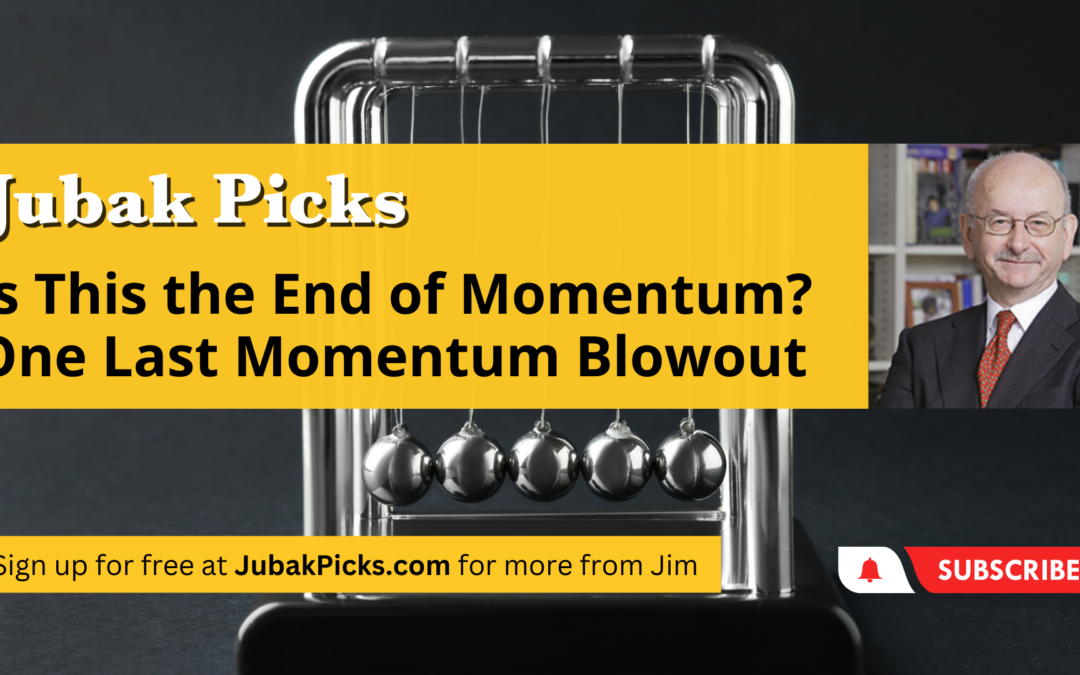
May 3, 2023 | Daily JAM, MSFT, NVDA, Videos |
Today’s topic is Is This the End of Momentum? One Last Momentum Blowout. This has been a great market for very specific stocks. We’re seeing a very narrow momentum market. A few stocks are overperforming the index and propping it up. An example is Meta Platforms (NASDAQ: META), formerly known as Facebook. Meta is up 102% this year and it’s up about 14% in the last month. The S&P is up 9.5% year to date and just 1.5% in the last month. We’re seeing a large divergence between the index and a narrow group of a few rallying stocks, like Meta, Netflix, Microsoft, and Nvidia. These stocks are outperforming the index, but they’re up based on very recent history. Meta’s recent earnings jolted the stock upwards, but it’s still a company that is bleeding money to develop its virtual reality products, with billions of dollars ($13.7B in 2022) lost by its Reality Labs program. The company had staked its future on the Metaverse but has yet to create a viable product from the project. As the momentum of these few stocks starts to slow, Meta could take a big hit because of these fundamental factors. In my opinion, we’re near the top of this momentum market and it’s time to start taking profits from companies like Meta, Microsoft, and Nvidia.
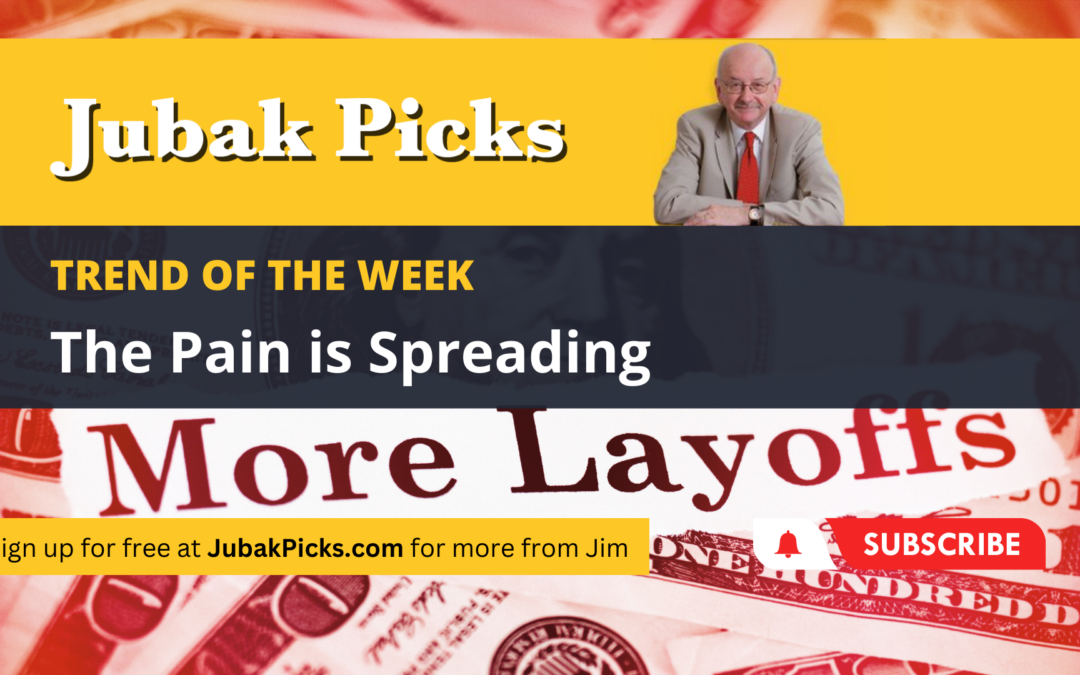
May 2, 2023 | Daily JAM, Mid Term, MMM, Videos |
This week’s Trend of the Week is The Pain is Spreading. By pain, I mean layoffs. It started with technology companies as we saw job cuts from companies like Meta Platforms, Amazon, and Alphabet. Then recently announced cuts of 7,000 employees. Now, layoffs are spreading to other areas of the market. 3M (NYSE: MMM), a generally reliable blue chip stock, announced they’d be cutting 2,500 jobs back in January and have now added 6,000 more jobs to the chopping block- about 10% of their total workforce. This is in reaction to slowing sales and the potential for losses from liability lawsuits. In the most recent quarter, organic sales were down 4.9% (better than the expected 6.9%) with a guidance of a 2% sales decline for 2023. While 3M is trying to cut costs with layoffs, Wall Street remains skeptical. 3M hasn’t seen the rally other blue chip stocks have seen recently. The company has so many products out there, it is representative of the market as a whole. And this one example plays into the bigger picture of the slowing economy, greater job losses, and, possibly, a recession.

April 27, 2023 | Daily JAM, Videos |
Today’s Quick Pick is Procter & Gamble (NYSE: PG). P&G’s first quarter earnings were good and a bit of a surprise. Reporting at $1.37 for the quarter, they beat Wall Street expectations ($1.32) by five cents and they were up 4 cents year over year. The company also raised guidance for revenue growth to 4% in 2023, higher than the prior 1%. While the report was good, it wasn’t that much better–it was a modest beat. What interests me is the market’s reaction to the report. The stock has been rallying since early March, but when P&G released the report, the stock jumped 3.7%. To me, this shows a hunger in the market for the (supposed) safety of blue chip stocks. As worries of a slowing economy and a possible recession grow, stocks that produce reliable, regular growth become more valuable. As I mentioned in my 10 Picks to prepare for a recession on JubakAM.com, P&G is a good place to be during a mild recession. Different story in a major downturn. Then everything falls.

April 26, 2023 | Daily JAM, Videos |
Today’s topic is Look Out Below! Central Banks to Take Away $1 Trillion in Cash. Citigroup recently reported that central banks pumped about $1 trillion into the financial markets during the recent bank-collapse crisis. While investors are currently focused on interest rates and inflation and how that affects the price of money, they may be overlooking this important liquidity story. Citigroup projects that this much liquidity injected into the financial system is equal to a rate cut of 50 basis points. The market indeed has received the rate cut it was looking for, just not where it was expected. We’ve now seen peak liquidity. Central banks will not keep putting this kind of liquidity into the market, and in fact, will try to take some of it back. Citigroup says we’ve gone through a risk-on rally fueled by extra cash from central banks, making junk bonds and high-risk investments very attractive. We also had a rally in corporate debt, as investors felt they could take on more risk with more cash in the market. Taking all this out of the market will make risk less attractive.

April 24, 2023 | Daily JAM, Videos |
This week’s Trend of the Week is Consumers Are Falling Behind on Debt Payments. Although the economy has been slowing for some time, there’s been a lag in consumers falling behind on debt payments. Until recently, consumers seem to have been relying on funds saved during the Covid crisis, but we’re now starting to see that life raft disappear as consumers start to sink underwater on debt payments. This isn’t a good sign for banks that may already be struggling with unrealized losses from the banking crisis. Wells Fargo recently put aside $1.2 billion for potential loan losses and other banks are following suit. About 20% of consumers are using “buy now, pay later” credit card features for things like groceries, showing that the slowing economy and slowing wage growth are finally catching up with consumers. Watch those delinquency rates going forward.

April 20, 2023 | Daily JAM, Jubak Picks, NEM, Videos |
Today’s Quick Pick is Newmont Corporation (NYSE: NEM). Newmont is the world’s largest gold miner but the stock hasn’t benefited very much from the recent rallies in gold. Unlike Barrick Gold, Newmont is not a low-cost miner, but it does have huge reserves as well as promising joint ventures–including one with Barrick in Nevada. The company is growing production and produced about 2.2 million ounces of gold in 2022, with production going up to a forecasted 2.7 million by 2027. Newmont likely hasn’t seen a huge rally yet because of the cost of energy. Mining gold takes a lot of energy and with recently higher gas/diesel prices, costs of mining and production have gone up and margins have been squeezed. However, looking forward to mid or late 2023, those margins will, in my opinion, start to look a lot better. If we hit a recession while inflation remains relatively high and energy prices come down, Newmont will benefit from lower costs and recession gold rallies. I would call Newmont my second choice gold stock to Barrick. Morningstar rates Newmont at 10% undervalued right now. This is a good time to buy and look for it to outperform in the second half of 2023.
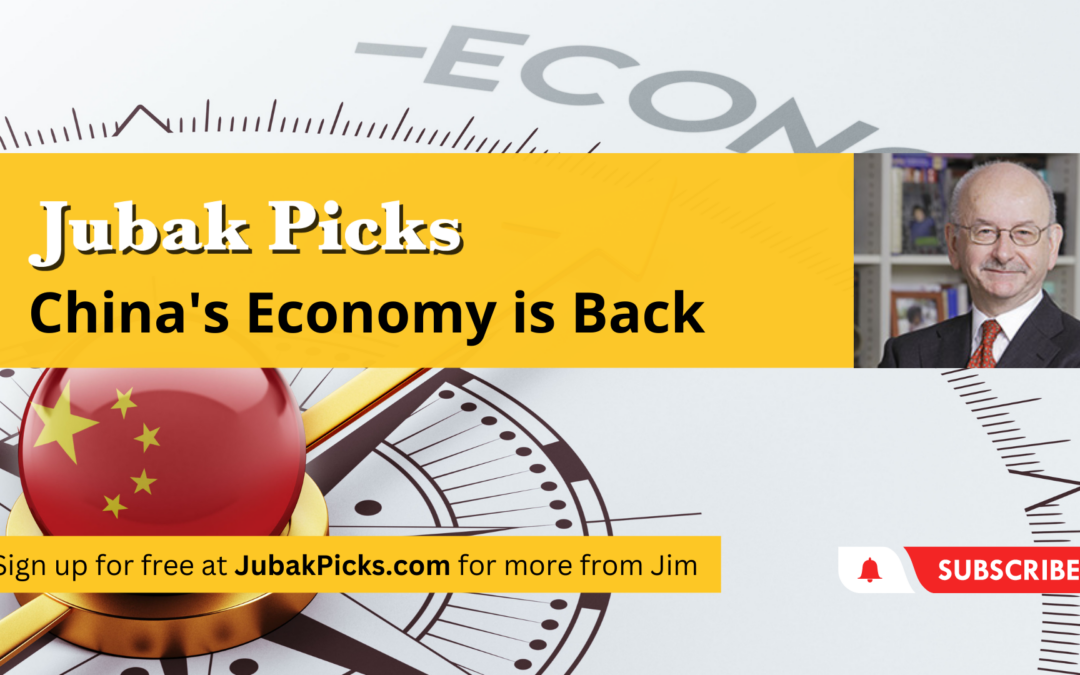
April 19, 2023 | BABA, Daily JAM, FXI, JD, Videos |
Today’s topic is China’s Economy is Back. On April 18, China reported 4.5% year-over-year GDP growth for the first quarter. While it wasn’t the 5% growth rate that the Chinese government has set as a target, it was better than the 4% forecast by economists. This growth rate comes on the heels of a 4th quarter with only 2.9% year-over-year growth. Other numbers showed strength too. For example, retail sales rose 10.6% year-over-year beating forecasts of 7.4%. But the economy isn’t cooking on all burners: Industrial production was up only 3.9%, just missing the forecasts of 4%. The iShares China Large-Cap ETF (FXI) is a good way to buy into China’s economy. There was a big rally from November to December as investors anticipated China’s economy speeding out of its Covid slump. But that rally was followed by a drop as the Chinese economy struggled with a resurgence in Covid cases. Now we’re seeing that drop start turn around. Individual stocks like Alibaba (BABA) and JD.com (JD) show charts with a similar pattern and can be expected to start to climb as the economy continues to pick up.
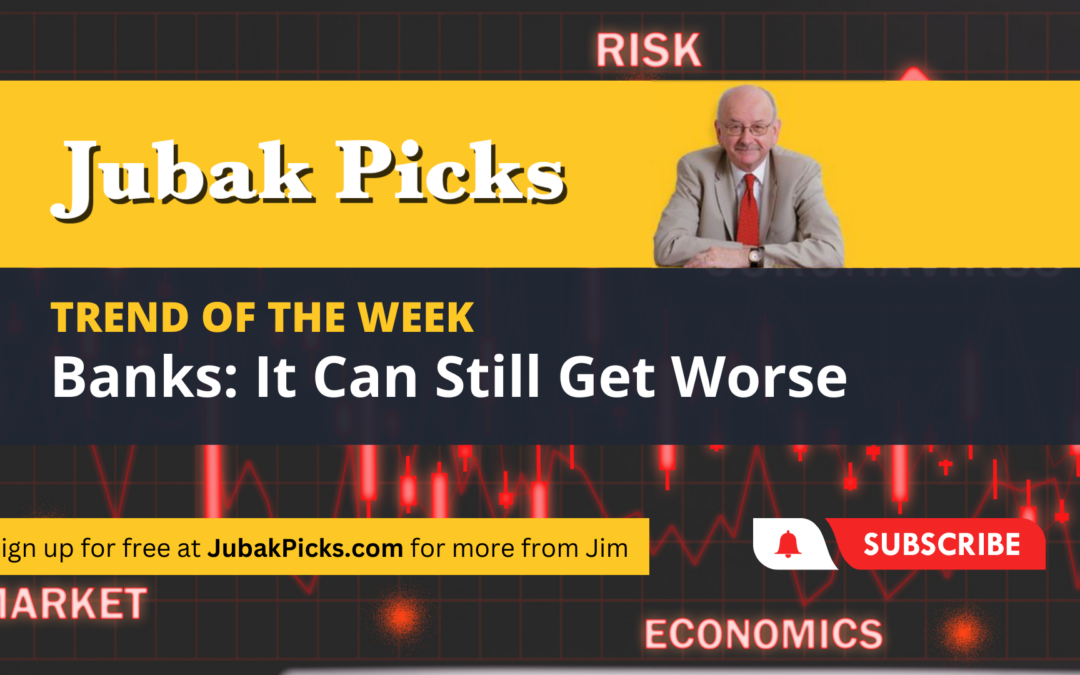
April 18, 2023 | Daily JAM, Videos |
This week’s Trend of the Week is Banks: It Can Still Get Worse. First Republic (FRC) is an example of a really hammered regional bank. They have about $4.2 billion in unrealized losses and the bank doesn’t look viable. On March 6, FRC stock was at $122, and by March 20, it had dropped to $12 and hasn’t really gone up since. Most recently, on April 10, the bank announced it will no longer pay the dividend for preferred shares–a surprising move as preferred shares are generally safe from such dividend cuts. This is just one example of how it’s still possible for things to get worse in the sector. As bank earnings season gets underway, you can expect a lot more bad news, with banks reporting high amounts of unrealized losses. In some cases, those unrealized losses could truly imperil the banks. I’m not sure where the worst problems will be and which banks are most affected, but we’ll see them start to pop up as earnings reports come out and banking Whac-A-Mole begins.

April 13, 2023 | Daily JAM, Jubak Picks, MRNA, Videos |
Today’s Quick Pick is Moderna (NASDAQ: MRNA). You’re familiar with Moderna as the developer of one of the RNA-Covid vaccines. The stock market has been treating the stock like the company was a one-trick pony with sales dependent totally on the demand for Covid-19 vaccines. But I think of the MRNA Covid-19 vaccine as proof of the validity of Moderna’s technology platform which takes a lot of the risk out of what is still an early-stage biotech stock. The company now has 36 other vaccines in its development pipeline using the mRNA technology that was proven effective in the Covid vaccines. Around six of those are expected to launch in the next few years. The huge jump in revenue from the Covid vaccines “shot” the stock up around 900%. (The company’s revenue was $155 million in 2018, and at the end of 2022 its revenue was $19.3 billion.) But more recently, the shares have been in a steep decline and Morningstar now calls them 40% undervalued. The stock has pulled back further in the last week or so on news that results from some trials have not been positive enough to lead to early termination of the trials. The huge revenue–and the resulting profitability–from the Covid-19 vaccines put Moderna in a unique position for such a young biotech company. They’re able to fund their own research, clinical trials, and the development of new products internally. That means the company doesn’t have to sell off a share of future profits and revenue on new drugs or vaccines in order to fund research and development. I’ll be adding the stock to my Jubak Picks portfolio tomorrow, April 14.
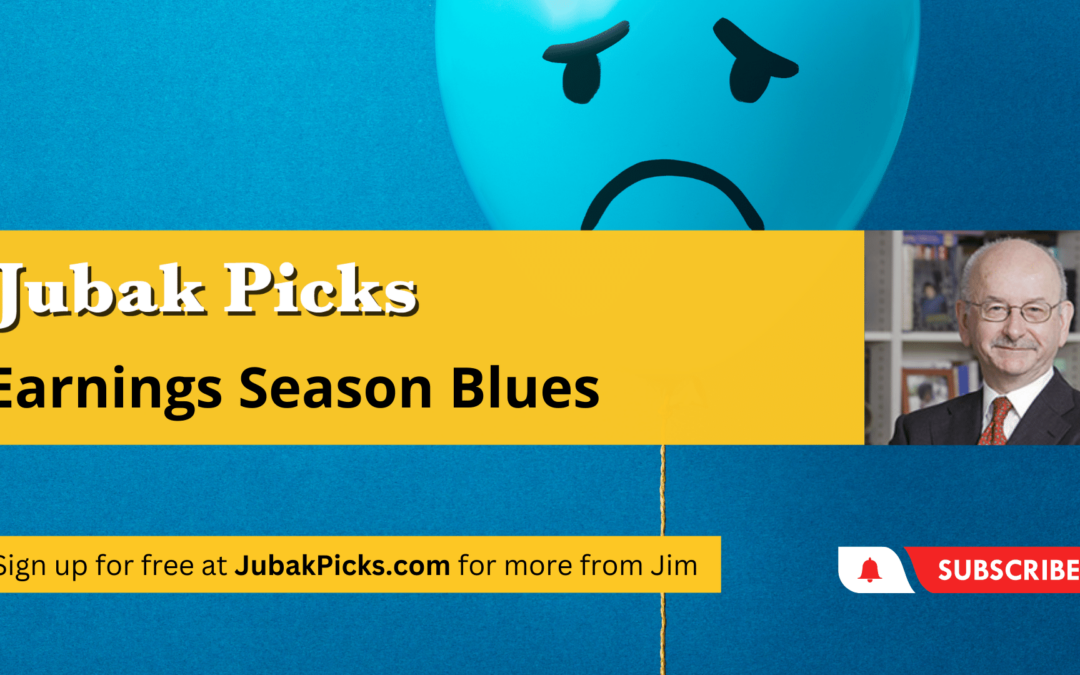
April 12, 2023 | Daily JAM, Videos |
Today’s topic is Earnings Season Blues. We’re looking at an earnings recession. First-quarter earnings reports will start dropping Friday with the big banks reporting numbers. And the projection from Wall Street analysts is for a 6.8% year-over-year drop in earnings from the companies in the Standard & Poor’s 500. This comes on the heels of a drop of 4.6% year over year for the fourth quarter. That would mark two negative quarters in a row. The second quarter 2023 projection is another year-over-year decline of 4.6%. These drops reflect higher inflation, higher costs, and slowing demand. Interestingly, the stock market has stayed within a range since December 2022–with stock prices not really reacting to negative earnings news. The market is showing investors and traders still hope the Fed will bail out the market by cutting rates in 2023 or 2024. This hope balances out the negative news coming from earnings reports and projections. That balance could start to falter if we continue to get negative earnings (which we will), and the Fed disappoints by continuing to raise interest rates. The most recent inflation numbers show that inflation is coming down (slowly) overall, but core inflation was actually up slightly, leaving the Fed’s decision on when to stop the hikes up in the air.















